1 October, Lima
The first day for the new group, and a tour of Lima on the agenda. For me a new guide, Caesar, to work with. Through the day Caesar provides the best, and the most comprehensive, summary of Peruvian history that I have heard so far - if any of us only retain 1% of what we were told we will be doing well! The problem with knowledgeable and enthusiastic guides is how to interrupt their flow to suggest that some people are flagging (after a days flight), and are hungry (after airline food the day before). After the San Francisco monastery and the Cathedral, interspersed with the changing of the guard at the Presidential Palace (with the band playing slow marching versions of Carmina Burana and El Condor Paso), I managed to get a break for lunch. Having seen the buildings before I was more interested in the people in the main square: the tourist police-women with their long hair in a tight bun behind their caps, the short lady in a red dress carrying an enormous bunch of white flowers across the street, the diminutive street cleaner all in orange sweeping up the cigarette butts from between the crowd watching the guards....After lunch we went to the Larco Herrero museum, and this time spent some time in the store having some of the developments in the Peruvian understanding of their own pre-Inca history, as revealed through the pottery, explained. The mystery for me is how such a huge collection of pots in pristine condition has survived. I don't think anyone can fail to be moved by at least one of the designs of the pottery, whether it is the animal or human faces depicted, the stories drawn on the pots, or the interesting sexual combinations displayed in gallery no. 3!
After dinner three of us ventured out to Miraflores Central Park, where as well as the numbers of people strolling up and down, there was a crowd surrounding a sunken 'stage' in the park where singers were performing. We didn't recognise the songs (apart from 'Happy Birthday' that rang out at one point), but the crowd seemed to be familiar with both songs and the local singers. Great to see such a vibrant part of town.
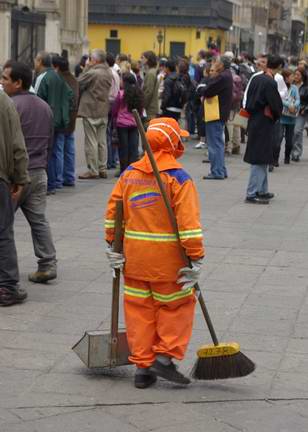
Street cleaner in Lima |
2 October, Arequipa
The best way to escape the grey in Lima is to hop on a plane, and you are through the thin layer of gloom within minutes! By 09.30 we were on our way south over the dry plateaus to Arequipa - not that I could see anything from the aisle seat. As usual the view across the tarmac when we arrived was stunning, with Chachani volcano rising up behind the airport, although with no snow on top now.You would think that there would be nothing new on a fourth visit to Arequipa, but wrong! Firstly there were clouds around the peak of Chachani in the afternoon - something not seen in Arequipa for a long time. Secondly we visited an alpaca wool factory, and were able to feel the incredible lightness and softness of the wool before it had been processed. And finally, I had time to visit Juanita, the sacrificed young Inca girl of noble birth, who was found preserved in the ice on top of the volcano Ampato. It was hard to imagine the life of the girl in Cusco, being schooled in the knowledge that she would one day be sacrificed. The objects buried with her were fascinating; from her own clothes to pottery, dolls, bags and remains of food and drink - often in remarkable state of preservation. Well worth the visit.
Back on the streets at dusk the roads were crammed with the little taxis they have here (40,000 I think the guide said!), all with illuminated signs on the roof, making a colourful but polluting cavalcade up the old streets of Arequipa.

Alpaca wool |
3 October, Chivay
Election day in Peru, and everyone over the age of 18 has to vote (and then get an inky finger, and a sticker on their identity card, enabling them to travel) or else face a fine. So the streets of Arequipa were almost empty, except by the schools being used as polling stations, where there were long queues and jams of taxis and collectivo buses. Both our guide and driver set off to vote early, but were thwarted by queues, so we started our journey to Colca Canyon late in the morning.There was a thin layer of high cloud, which reduced the glare from the sun and enabled the varied colours of the volcanic rocks on Chachani and the other volcanoes on our route really to shine clearly - multiple hues of white, brown, red. In the distance, half hidden by haze, was the snow-capped volcano Ampato, where Juanita, the ice-maiden, and 2 other sacrifices had been found.
Going over the highest point of our trip, over 4,800m, resulted in inevitable headaches and tiredness, so the rest of the day was supposed to be restful, although most of the group headed into the village of Chivay in search of water and bananas, the travellers stock supplies!
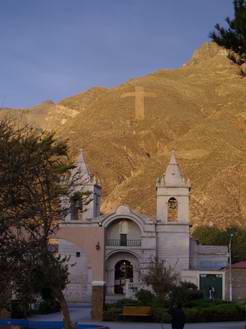
Sunset, Chivay church, Colca Canyon |
4 October, Chivay
An early start at 06.30 in order to reach the viewpoint above where the condors nest by 08.30. At this time the air is warming up and the thermals used by the condors to climb out of the canyon are beginning. We had been warned that as the condors were nesting they may not follow their normal behaviour and appear, at all. However, as we arrived a trio of condors was already in the air, followed over the next hour by many others (or the same ones over again....). There were several juveniles, mostly brown rather than the dramatic black and white upper wing colours, and they appeared to be launching from the nesting area below us. What luck to see so many. Even when we had stopped watching, and had set out for a walk from the viewpoint, 'the family' reappeared for another flypast. Unlike on previous visits, when the condors had simply circled higher and higher and then disappeared, the condors this time seemed to be doing short flights from their nests or perches. Wonderful.Without the condors the journey in and out of the canyon, with views over the terraced sides of the canyon and up to neighbouring volcanoes with their brown, white and red rocks, was still spectacular.
The day was rounded off by a visit to the hot springs just outside Chivay. Lying in 39°C water, looking up at the rocky canyon sides in the late afternoon sunshine, what more could you want?
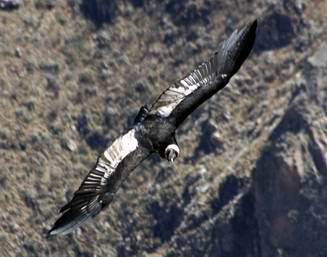
Adult condor over Colca Canyon |
5 October, Puno
We left the pleasant chalets of the Hotel Andina in Chivay at the same early time as the day before. The only advantage I could see was that the surrounding hills looked stunning in the morning light. We stopped at the top of the pass to view the distant volcanoes, and then headed down again to the café at Chasquipampa. As we were so early the place, usually full of coaches, was deserted. The local women had yet to set up their stalls, and were arriving, pushing their bags of knitwear on tricycles. They start the day dealing with their alpacas and llamas, then sell souvenirs to tourists until mid afternoon when they return to farming duties. A hard life.Having got up so early it was hard to stay awake as the coach headed across the high plains towards Lake Titicaca. The result was that most of us only got fleeting glimpses of the landscape, the Puna hawks and mountain caracaras that flew past, and the lonely semi-ghost towns along the now freight-only railway. We did stop for the flamingos though, and were lucky later to see some in flight heading up the valley towards Laguna Lagunilla.
Having got up so early did mean we got to Puno early, so had a relaxing afternoon either sleeping, or exploring the town. At 18.00 the thump of drums signalled another procession through the streets - this time primary school children in traditional (mostly) dress carrying paper lanterns. This town never stops processing! (see last tour.)

Bringing the crafts to the tourist stop |
6 October, Puno
A memorable day, that started with the strange sight outside the hotel of women in traditional dress sitting on the pavement outside the Banco de la Nacion. At one point they were moved to the opposite street corner, and dozens of women appeared from round the corner, and eventually the queue stretched up the whole block. As the bank still had an hour and a half before it opened this was all very puzzling. Once our guide, Felix, arrived we had an explanation: this was the day when the women from a Lake Titicaca peninsula received 150 sol (about £34 currently) from the government, provided their children had attended school - a monthly allowance in the cause of literacy.The memorable day came not from this sight, but from the fact that it was Trevor and Jean's 50th wedding anniversary, which added romance to the usual wonderful sightseeing programme. When one of the families on the Uros floating islands that we visited heard it was their anniversary, they gave them a little present., the hotel decorated their bed with red petals in a heart shape (no-one owned up to telling the hotel!), and the restaurant in the evening produced a very tasty chocolate cake with a couple of candles on it. Add the Pisco Sours that Trevor & Jean offered, the walk through the stone-walled fields of Taquile Island, the sunshine, the blue water and it was a truly memorable day!
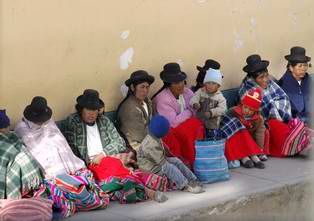
Quechua women queuing outside the National bank |
7 October, Cusco
A glance outside the hotel window revealed another queue of ladies
outside the bank - this time with different hats i.e. from a different
area, and apparently Aymara speakers, rather than Quechua speakers the
day before. This time too there was a refreshment trolley selling
quinoa juice, and a man selling basic text books up and down the queue.
As the queue was on our way to the coach transferring us to Cusco I
think we all stopped to photograph the colourful display.The journey was fascinating (all 380km of it!), with a stop to see the weird funeral towers at Sillustani, and a visit to a nearby altiplano 'ranch', where we tasted freshly baked quinoa bread and very salty cheese. As we were there the local primary school children raced past, chanting as they ran, with their school banner held high at the front of the race. Some PE lesson! En route too we saw an unusual method of transporting sheep, namely on the roof rack. Unfortunately as the roof-rack was on top of a mini-bus this involved the poor sheep being manhandled and hauled up by rope. I presume the two sheep were then bound to the roof-rack - very undignified.
We arrived in Cusco at dusk, so no time to experience the historic centre apart from the Inca walls near the hotel - so the main impression of Cusco was a busy, traffic-filled, rather ugly, modern badly constructed city!
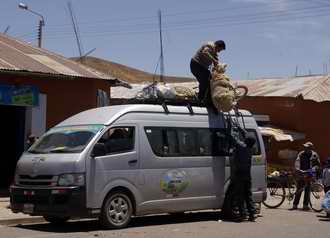
That's one way to transport sheep! |
8 October, Cusco
A fine day, but with clouds in the sky - something we hadn't seen since the grey of Lima. Today was Cusco and surrounding Inca sites day; first travel in the coach out to Tambomachay (water worship), then a walk to Puca Pucara (lookout) and on to Q'enqo (labyrinth) and finally by coach to the massive ruins of Sacsayhuaman (various spellings). At the latter site it is hard to visualise how the builders moved the huge stones in the lower zig-zag ramparts, let alone shaped them to fit perfectly with the adjoining stones. Also puzzling was the origin of the rock in the middle of the site: waves of smooth laminated rocks quite at odds with the adjacent limestone - but perfect for kids to slide down.In the afternoon we survivors (as three had gone down with stomach problems) toured the centre with Ubaldo, our 'Inca' guide to the physical and spiritual history of Cusco. As it was a holiday (commemorating losing the war with Chile in 1883..) the centre was quiet and half closed - including the market, usually buzzing with activity, but half empty when we toured round it.
In the evening we ate out at Tupana restaurant, a memorable evening not on account of the buffet (excellent) or the music (pretty good), but for the last dance performance which turned into a mass joyful prancing with dozens of school leavers from Lima. Somewhere out there there are some incriminating photos....
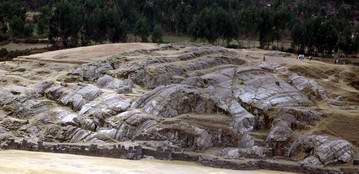
Rock formations at Sacsayhuaman |
9 October, Cusco
The day to visit the Sacred Valley of the Incas, and there were even more clouds in the sky. However as we set off from the top car park at Pisac the weather still looked good. It wasn't until after we had looked at the distant cliff with Inca tombs located in impossible locations that the first drops of rain on this tour began to fall. At the same time there was a bright rainbow halo around the sun; Inca site, Inca flag colours in the heavens - a sign?Whatever, the rain made the descent on uneven stone steps and paths somewhat treacherous, but we all made it safely to the market square in Pisac for lunch. Then it was on to Ollantaytambo, and suddenly we hit crowds of people, all ages and nationalities. This made it difficult to see some of the best examples of stonework, as they were obscured by people being photographed in front of the stones.
Back in the bus, and a short journey before stopping at a house selling chica, the local corn 'beer'. Such houses are identified by a pole with a red plastic bag attached to the top. We sat in the brew house, the smell of wood smoke filling the air, and tasted two type of the liquor, one straight chicha and the other, more palatable, flavoured with strawberries. The atmosphere was great, but the straight chicha less so!
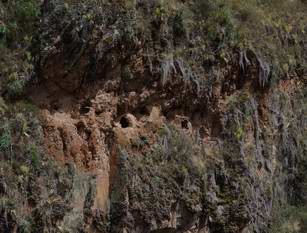
Inca tombs at Pisac |
10 October, Machu Picchu
We had a horribly early start in order to catch the 06.53 train to
Machu Picchu, but this was followed by 3½ hours of interesting
landscape sliding slowly by as we descended to the Urubamba valley. Our
second breakfast, on the train, was a selection of tasty delicacies
served on a wooden tray complete with a small pot of everlasting
flowers. On arrival at Aguas Calientes we shopped quickly for snacks in
the market, and then queued for the bus to take us up to Machu Picchu
itself.It wasn't long after starting the tour that it began to rain. It wasn't until we wanted to stop for a lunch snack that the rain began to fall more heavily. Ubaldo, our guide, having spent 16 years living on the site knew of a large overhanging rock that just about had enough space for us to shelter under and nibble.
It was at this point that I realised that the return bus tickets for the group were in my other rucksack, safe and dry in the hotel down in Aguas Calientes! 40 soles, 1½ hours and two bus rides later I met the cold and wet group at the entrance of the site to go back down - the usual free time to wander round the site proving not so attractive in the rain....
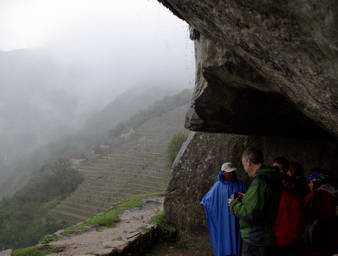
Sheltering under a rock at Machu Picchu |
11 October, Cusco
The morning dawned cool and dry, with wispy clouds hanging around the
mountain sides. Most of us walked down the Urubamba valley on the bus
route, quiet before the first train arrived, to the museum of Machu
Picchu and the adjacent botanical gardens. The museum was well laid out
and about the right level of information on the site and the Incas in
general - but very few people visit it as they either have no time
during a day visit, or it is too far to walk. It is a shame as a lot of
effort had gone into the presentation for few visitors.The botanical gardens were small but well labelled, and boasted lots of the orchids for which the area is renowned. Unfortunately very few were in flower!
Back at Aguas Calientes, after a filling lunch at the restaurant we had enjoyed the previous evening, the Indio Feliz, the rain began again - this time in earnest. For about half an hour there was torrential rain, filling in seconds the buckets that the craft market stall holders had put out.
Back on the train to Cusco we had the usual display by a colourfully dressed and masked dancer, and a fashion show of alpaca garments. Somehow the men's jumpers looked rather dull compared with the wraps and tops that the female 'model' paraded. The performance did create quite an animated atmosphere in the carriage, which was fun. Some even bought an item.........
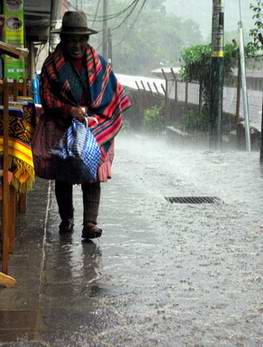
Aguas fredos at Aguas Calientes |
12 October, Iquitos
This was a day of travel, apart from an early morning tour of the Quoricancha with Ubaldo for some of the group. As our first flight from Cusco to Lima was with LAN, and the second flight from Lima to Iquitos was with Peruvian Airlines, we had to collect our luggage in Lima and check-in again - oh the joy of queueing! The slight advantage of changing airlines was that we got a different, and slightly better, snack on the second flight. The descent into Iquitos was rather unnerving, as there is total darkness all around until a few seconds before touch-down, when some buildings and lights suddenly appear near the wing-tip.Iquitos was buzzing with mosquitoes, as usual. Not the insects, but the motor-bike taxi variety, weaving in and out of the traffic, which comprised few cars but plenty of old buses with wooden canopies and no windows.
"This postcard is blank" |
13 October, Heliconia Lodge
The stay in Heliconia Lodge, after a fast transfer by a weaving speedboat, due to trees and other debris floating down the river, is supposed to be relaxing. However due to some rooms not being ready, and an extended session fishing, it all seemed a bit of a rush. The fishing, with simple sticks, line and hook spiked with small chunks of meat, was surprisingly successful with a number of wriggling species of piranha and Amazon sardines being caught. I am not sure who was more surprised, the fish or the person dangling the line in the reeds beside the boat! At the front of the boat, our guide Victor, was constantly hauling fish out of the water - we suspected a bucket of fish hidden below the prow....After the fishing we went on a hunt for the river dolphin which, after we had circled around for a while, appeared with its fin gently breaking the surface of the river. No sign of the pink dolphins, however.
The return up the river in the two-story wooden "Spirit of the Amazon" seemed to take forever, and we watched a glorious sunset before arriving at the lodge. Ten minutes later we were back together for a night walk which featured tarantulas and a number of huge owl butterflies with big 'eyes' on their wings.
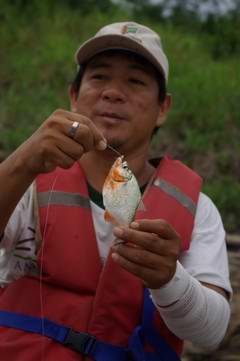
Victor with a red-bellied piranha |
14 October, Heliconia Lodge
The day started early at 06.00 with a bird-watching cruise up the Amazon. Despite not being able to enter the side creeks, as the water was too low, we did see (and mostly hear) a satisfying number of birds - just about justifying the early start!It was only three weeks ago that I was last in the lodge, but since then a freak whirlwind had felled many trees. The fallen trees had almost completely destroyed the board-walks leading through the jungle behind the lodge, and had also wiped out several of the rooms that the last group had stayed in. This chaos meant that our jungle walk in the morning became a more serious enterprise, with Victor swinging his machete frequently in order to force a new trail to avoid the fallen trees. We had a glimpse of distant monkeys, heard the constant sound of birds that refused to show themselves, saw countless butterflies, red flowers and fungi. The darkness under the forest canopy meant that photography was challenging, and usually accompanied by a flash.
In the afternoon we visited a Jaguar village of yesteryear - the villagers dressed up in grass skirts and lamely doing a dance for us before demonstrating the blowpipe and selling crafts. More exciting was the walk through the current village - there was bunting everywhere as the village was celebrating 24 years of existence, and two games of vigorous football were in progress - one barefoot (the women), and the other in trainers (the men). A few cows were grazing at the side of the pitch, and the atmosphere was friendly and lively.
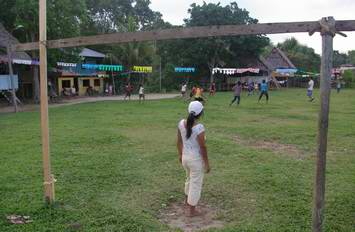
Janamona village: women's football |
15 October, Lima
Before having to head back to Lima we had a morning of Amazon experience. The Lodge's plan was to visit the giant water lilies (looking pretty shrivelled as their soggy habitat was drying up) and a sugar cane processing plant and distillery (and sample the output). The Amazon's plan was to demonstrate the power of the rain, and punish those who had forgotten to take their plastic ponchos with them. So it was that a pale pastel yellow-clad group filed off the boat, and into the shelter of the thatched sugar processing shed. We left a clutch of empty glasses at the distillery and headed back to the lodge to pack & have our last wholesome locally sourced meal - they may have been a bit repetitive, but were very tasty!Back in Iquitos some people explored the town a little; all of us re-packed our bags before heading off in the evening for our flight back to Lima. The flight was most notable for the interesting snack served - a ball of cold savoury mashed potato enclosing some vegetables, and a sweet of cold rice pudding with black corn syrup (sounds peculiar, but I thought it tasted good!).
Our final dinner in Peru started at the unwholesome hour of 22.30 - but it was amazing how many of us actually ate most of the meal....
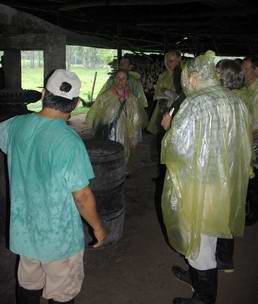
Distillery visit in the rain |
16 October, The end
The last day in Lima (for the group, as I have to stay two more days and the next available flight back), and everyone dispersed in different directions, after having fought with the hotel's slow internet connection in order to bag reasonable seats on the long flight home.The word 'grey' has been used on most days in Lima, and this day was no exception - the only colour coming from the goods in the craft stalls, and the sponsored para-gliders cruising below the vultures on the wind rising up the pebble cliffs from the Pacific. I was amused to see a large 'Kotex' sanitary pad come flying over at one point!
The struggle to print boarding cards paid off at the airport, where we were able to avoid (some of) the queueing - it was hard to imagine all the people queueing for the flight being able to fit into one aircraft. Perhaps there was more than one plane?
The dispersal of everyone at the end of such and active and seemingly long tour is always somewhat sad - it is no longer a group, but a collection of individuals whose thoughts have already turned to home, the utility bills, committee meetings, Wednesday's golf, tomorrow's work, and the dripping tap in the bathroom. Oh, and the need to have another holiday to recover from this one!
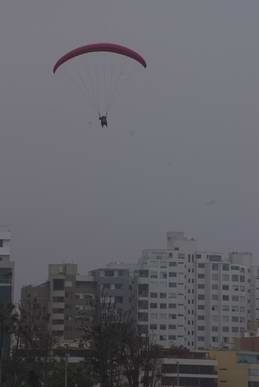
Paraglider on a grey Miraflores day |